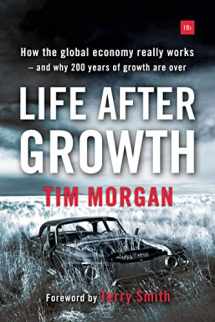
Life After Growth: How the global economy really works - and why 200 years of growth are over
ISBN-13:
9780857195531
ISBN-10:
0857195530
Edition:
2nd ed.
Author:
Tim Morgan
Publication date:
2016
Publisher:
Harriman House
Format:
Paperback
192 pages
FREE US shipping
Book details
ISBN-13:
9780857195531
ISBN-10:
0857195530
Edition:
2nd ed.
Author:
Tim Morgan
Publication date:
2016
Publisher:
Harriman House
Format:
Paperback
192 pages
Summary
Life After Growth: How the global economy really works - and why 200 years of growth are over (ISBN-13: 9780857195531 and ISBN-10: 0857195530), written by authors
Tim Morgan, was published by Harriman House in 2016.
With an overall rating of 4.0 stars, it's a notable title among other
books. You can easily purchase or rent Life After Growth: How the global economy really works - and why 200 years of growth are over (Paperback) from BooksRun,
along with many other new and used
books
and textbooks.
And, if you're looking to sell your copy, our current buyback offer is $0.3.
Description
NEW PAPERBACK EDITION WITH ADDITIONAL INTRODUCTION AND END NOTE FROM THE AUTHOR Why, years after the banking crisis, is the global economy still mired in recession and burdened by enormous debts? Why have the tried-and-tested economic policies of the past failed us this time? In Life After Growth, leading City analyst Tim Morgan sets out a ground-breaking analysis of how the economy really works. Economists are mistaken, he argues, when they limit their interpretation of the economy to matters of money. Ultimately, the economy is an energy system, not a monetary one. From this, it follows that we need to think in terms of two economies, not one - a 'real' economy of work, energy, resources, goods and services, and a parallel, 'financial' economy of money and debt. These two economies have parted company, allowing the financial economy to pile up promises that the real economy cannot meet. Starting with the discovery of agriculture, Tim Morgan traces the rise of the economy in terms of work, energy and resources. The driving factor, he explains, has been cheap and abundant energy. As energy has become increasingly costly to obtain, the potential for prosperity has diminished, to the point where growth in the real economy has ceased. An immediate problem is that our commitments - including debt, investments and welfare promises - cannot be honoured, which means that we can expect the financial system to be wracked by value destruction. At the same time, we need to adapt to a future in which prosperity can no longer be taken for granted.


We would LOVE it if you could help us and other readers by reviewing the book
Book review

Congratulations! We have received your book review.
{user}
{createdAt}
by {truncated_author}


